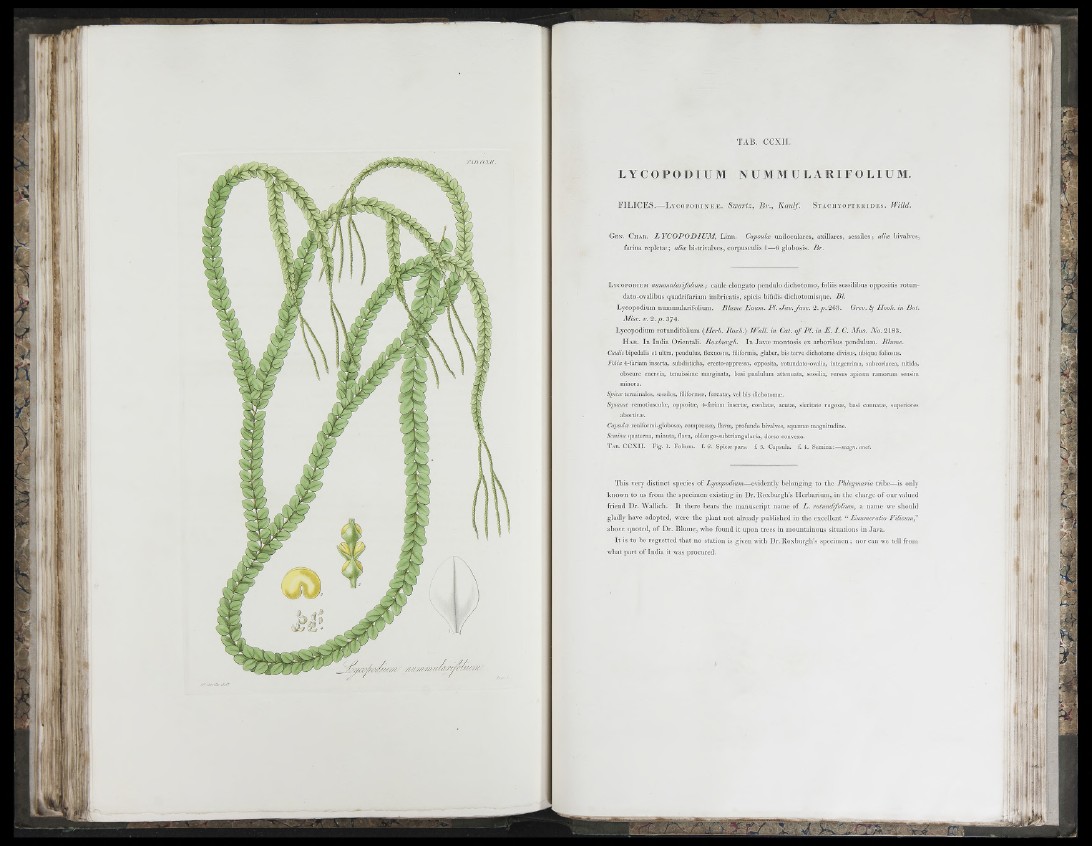
NH
' i'll
TAB. CCXII.
L Y C O P O D I UM N U M M U L A RI r O LI U M.
I'TLICES.— L y c o i ’O ü i n e æ . Swartz, B r ., Ka u lf. S t a c i i v o p t k k i d e . s . IVilld.
G en . C iia u . L Y C O P O D I U M , Linn. Capsidæ. unilocularcs, axillarcs, s e ssile s; aliæ bivalves,
farina repletæ ; ß/fte bi-trivalves, coiquisculis 1— 6 glob o sis. B r .
Lycopodium nummularifolium ; caule c lon gato péndulo d ichotomo, foliis sessilibus oppositis rotiin-
dato-ovalibus cjuadrifariam imbricatis, spicis bifidis dichotoniisqnc. Bl.
Lycopodium nuinnmlaritbliuni, Blum e E n um . P l. J a v . f a s e . 2. p . 2 6 3 . Grev. Hook, in B u t.
M is c . V. 2. p . 374 .
Lycopodium rotundifolium {H c rb . R o x b .) W a ll, in Cat. o f P l. in E . 1. C. M u s . N o . 2 1 8 3 .
H a b . In India Orientali. Ro x b u rg h . In Javæ mon to sis e x arboribus pendulum. Blum e.
Caulis bipedalis et ultra, péndulas, ilexnosus, filiformis, glaber, bis terve dichotome divisus, ubique foliosus.
Folia 4-fariam inserta, subdisticlia, erecto-appressa, opposita, rotundalo-ovalia, integerrima, siibcoriacea, nitida,
obscure enervia, tenuissime marginata, basi paululum attenuata, sessilia, versus apicem ramorum sensim
minora.
Spicæ terminales, sessiles, filiformes, furcatæ, vel bis dichotomæ.
Squamæ remotiusculæ, oppositæ, 4-ibriam insertæ, cordatæ, acutæ, siccitate rugosoe, basi connutoe, superiores
abortii’æ.
Capsidæ reniformi-globosoe, compressoe, flavæ, profunde bivalves, squamæ magnituiline.
Semina quaterna, minuta, flava, oblongo-subtrianguhiria, dorso convexa.
Tab. CCXII. Fig. 1. Folium, f.2. Spicæ pars. f. 3. Capsula, f .4 . Semina;—magn.aucl.
This very distinct species o f Ly co p o d ium— evidently b e lon gin g to the Ph legm a ria tribe— is only
known to us from the specimen ex istin g in Dr. Roxburgh’s Herbarium, in the charge o f our valued
friend Dr. Wallich. It there bears the manuscript name o f L . rolundifolium, a name we should
gladly have adopted, were the plant n o t already published in the ex c ellen t “ En um e ratio Filicum','
above quoted, o f Dr . Blum e, who found it upon trees in mountainous situations in Java.
I t is to be regretted that no station is given with Dr. Roxburgh’s specimen ; nor can we tell from
what part o f India it vvas procured.